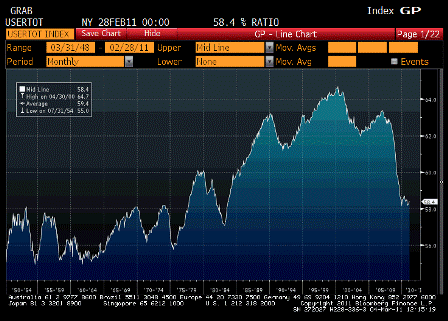From Goldman: The household survey, however, was stronger than expected. In particular, the unemployment rate dropped another tenth (to 8.922%) due to a firm gain in employment (+250,000) and unchanged labor force participation (at 64.2%). The employment gain was also strong on a “payroll-adjusted” basis, up 342,000 on the month. The employment/population ratio remained unchanged at 58.4%. The decline in unemployment was broad based across different measures of unemployment; for example, the U6 unemployment rate, which counts marginally attached workers and those working part-time for economic reasons, declined by two tenths to 15.9%
With only 58.4% of the population employed it’s a stretch for the Fed or anyone else to declare victory.
Yes, there are some long term demographic changes.
Women entering the workforce probably drove this ratio higher,
and an aging population is probably going to drive it lower.
But we’re back to levels from before women entered the workforce.
Best I can tell, yes, there are signs of improvement, but overall it remains an economic disaster.
Karim writes:
- Data still weather impacted as 82k workers more than avg couldn’t work due to weather
- Unemployment rate falls to 8.92% from 9.05% as household survey employment rises 250k and labor force rises 60k
- Payrolls up 192k, with net revisions of +58k and private sector job gains of 222k (68k last month)
- Avg hourly earnings unch after 0.4% last month (and likely hard to read due to impact on hours worked from the weather)
- Index of aggregate hours up 0.2%
- Median duration of unemployment down from 21.8 to 21.2 weeks
- U6 measure down from 16.1% to 15.9%
- And the strongest indicator in this report was the Diffusion Index reaching its highest level since 1988, rising from 60.1 to 68.2 (this is like the ISM, measuring the breadth of industries adding jobs)


